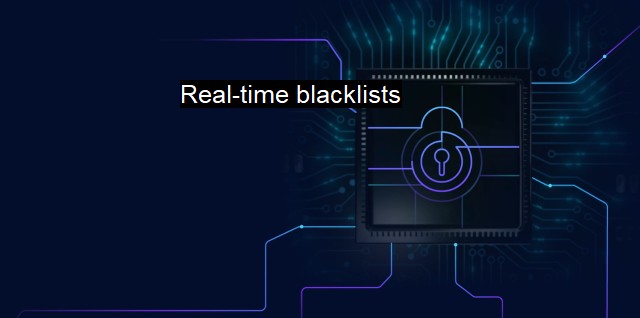What are Real-time blacklists?
How Real-Time Blacklists (RBLs) Are Empowering Cybersecurity Against Spam, Malware, and Other Cyber Threats
Real-time Blacklists (RBLs), which are alternately known as DNS Blacklists (DNSBLs) or DNS-based Blackhole Lists (DNSBLs), are a crucial aspect of cybersecurity. Primally utilized in email security to prevent spam, they monitor and block IP addresses known for malicious intention like sending spam or phishing emails. these lists serve as an efficient security tool to protect networks, computer systems, and even the behavior of internet users against harmful content.The RBL's mechanism is relatively simple. Whenever a user sends an email, the mailbox provider initiates a check with the RBL before delivering the email message. If the sending mail server of the email matches with any IP addresses listed in the RBL, that email gets blocked straightway. Validity questions can fall on the entire data sent from a blacklisted IP. Thus, presence on a blacklist can seriously impair an email sender’s reputation, potentially leading to entire emails never making it to their end recipient.
Traditionally, a group of administrators and mail experts usually maintain the RBLs and carry out regular updates. The decision to include a particular address involves scrutiny and analysis of activities originating from the IP. This further involves unbidden outbound emails, virus detection, and even using Big Data to extract predicative patterns of offending servers.
Still, blacklists are quite controversial due to their efficiency and tendency to flag legitimate addresses. One encounter is false positives, where a legitimate server gets incorrectly put on an RBL. This results from prevalent online spamming activities making it increasingly difficult to differentiate between authentic and inappropriate content. Hence caution and neutrality are indispensable during the process of compilation.
Smarter spammers regularly shifting domains or IP addresses present another challenge. This quick maneuvering makes RBLs less efficient because of the delayed time between identification, listing, and spam report actions.
Delisting or removing an IP address from a RBL is also a concern. Blacklisted IPs often involve a significant amount of resources and time to clear their reputations, and may also incur unnecessary costs for the victimized parties.
The effectiveness and efficiency of RBLs are undeniable. Its source from historically proven, tangible data makes it a practical indicator of web threats. A beautifully crafted email can trick a person, but the sender IP’s past cannot deceive a DNS-based check.
Real-time blacklists find their addition with other cybersecurity tools like firewalls, intrusion detection systems (IDS), anti-spam filter software, and antivirus software for comprehensive protection. Antivirus software, for instance, protects against harmful software or malware, including the most common ones like viruses, worms, ransomware, and spyware. employing RBLs in addition can further strengthen security measures to minimize accidental or malicious threats.
Interestingly, with the proliferation of malware variants daily and an escalating spike in cyber threats, the dynamic use of RBLs offers potential protective avenues. Machine-learning-based algorithms and Artificial Intelligence can fuel the efficacy of cyber defense mechanisms by predicting potential threats via pattern derivation. This striking feature can augment security equipment's capacity, making robust blacklists that catalog and counter ever-changing cyber threats.
Real-time Blacklists constitute a method to tackle cybersecurity threats directly. like every system, they also come with embedded loopholes. Accessibility to database exposure, system analysis expertise, and algorithmic competence can work in symbiosis with human decision-making to make RBLs even more formidable shields in the future. Until then, it is essential to consider RBLs as one of the many tools for handling online security but not an absolute solution. This idea reflects the continuous expansion, evolution, and complexities of the cyber threat landscape, and hence calls for constant development, adaption, and improvement in existing cybersecurity best practices.

Real-time blacklists FAQs
What are real-time blacklists (RBLs)?
Real-time blacklists (RBLs) are lists of IP addresses that are known to be sources of spam, malware, or other malicious activities. These lists are used by cybersecurity and antivirus systems to identify and block potentially harmful traffic.How do real-time blacklists work?
Real-time blacklists work by maintaining databases of IP addresses that have been identified as sources of malicious activity. When a cybersecurity system receives traffic from an IP address, it checks the address against the RBL to see if it is on the list. If it is, the system can block the traffic, preventing it from reaching its intended destination.Are real-time blacklists effective at stopping cybersecurity threats?
Real-time blacklists are one of many tools that cybersecurity teams use to protect their networks and systems. While they can be effective at stopping known threats, they are not foolproof and cannot stop all types of attacks. As such, it is important to have a layered approach to security that includes multiple tools and strategies.Are there any downsides to using real-time blacklists?
One potential downside of using real-time blacklists is the risk of false positives. If an IP address is mistakenly added to an RBL, legitimate traffic from that address may be blocked. This can potentially cause problems for users and businesses that rely on that traffic. Additionally, some cybercriminals may use tactics to avoid being added to RBLs, such as frequently changing IP addresses, which can make it more difficult to effectively use these lists.| | A | | | B | | | C | | | D | | | E | | | F | | | G | | | H | | | I | | | J | | | K | | | L | | | M | |
| | N | | | O | | | P | | | Q | | | R | | | S | | | T | | | U | | | V | | | W | | | X | | | Y | | | Z | |
| | 1 | | | 2 | | | 3 | | | 4 | | | 7 | | | 8 | | |||||||